1. Meet the Nvidia Geforce GTX 1080
Nvidia has recently unveiled their latest high-end graphics cards for gamers, called the GeForce GTX 1080 and GTX 1070. The company' s CEO Jen-Hsun Huang made claims of big performance gains and new-found levels of efficiency at attainable price points for the masses. With today’s official launch of these new graphics cards based on Nvidia’s new Pascal architecture, the GeForce GTX 1080 promises to deliver the goods on all fronts in performance and value, at an impressive performance-per-watt metrics. This is in-part due to Nvidia’s move to a 16nm FinFET manufacturing process with fab partner TSMC.
The GP104 GPU under the hood of Nvidia’s new GeForce GTX 1080 is comprised of some 7.2 billion transistors and has a die size measuring 314mm2. The company’s previous generation Maxwell architecture-based GeForce GTX 980 has a GPU die that measures 398mm2 and is made up of roughly 5.2 billion transistors. That equates to 2 billion more transistors in about 20 percent less die area for the new GeForce GTX 1080 Pascal-based GPU.

Nvidia also redesigned key ares of the architecture, like the memory IO structure, including taking advantage of Micron’s latest GDDR5X memory technology, enabling 320GB/sec of bandwidth versus the previous generation GTX 980 at 224GB/sec. Nvidia also implemented new color compression algorithms to decrease memory and cache utilization and introduced asynchronous compute support in addition to a new compute technique call "premption" that allows the GPU to render workloads in a more parallelized manner, for better efficiency. These features also afford the architecture lower latency and faster rendering in VR applications, especially when combined with new features like Nvidia’s Simultaneous Multi-Projection technology that can perform image aspect correction in a single pass in VR apps, without having to do double the geometry work like previous-generation architectures.
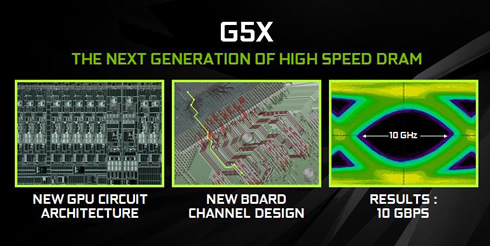
Here are the specifications of the new GTX 1080, as well as the two other Nvidia graphics cards we have added in the performance comparison charts of this brief review -- the GeForce GTX 980 and the overclocked Zotac GeForce GTX 980 Ti:
|
GeForce GTX 1080 |
GeForce GTX 980 |
ZOTAC GeForce GTX 980 Ti AMP! Extreme |
| Architecture |
Pascal (GP104) |
Maxwell (GM204) |
Maxwell (GM200) |
| Manufacturing process |
16nm |
28nm |
| GPU clock (maximum) |
1,733MHz |
1,216MHz |
1,075MHz |
| Cuda cores |
2,560 |
2,048 |
2,816 |
| Texture units |
160 |
128 |
176 |
| Memory |
8GB GDDR5X |
4GB GDDR5 |
6GB GDDR5 |
| Memory Clock |
10GHz |
7.0GHz |
| Memory Interface |
256bit |
256bit |
384bit |
| ROP units |
64 |
64 |
96 |
| Board Power |
180W |
165W |
250W |

The new GeForce GTX 1080 will retail for $699 in the Founder’s Edition model that was tested; $599 for standard edition models.
The GTX 1080 maintains the look and feel of the reference cards going back as far as the GeForce GTX 780, although the new card features a silver heatsink. Measuring 10.5in long and fitting into the dual-slot form factor, the reference card is now called the Founders Edition (FE).
The 180W card is kept cool using a heatsink-and-fan unit. Nvidia outfits its own card with a single 8-pin power connector, moving away from the dual six pins on the similar-wattage GTX 980.

A look at the back shows that Nvidia hasn't changed the outputs in the move from GTX 980 to GTX 1080. Dual-link DVI, for legacy reasons, sits on top of a trio of DisplayPort and a single HDMI 2.0b.
The DisplayPort is 1.2 certified and spec 1.3/1.4-ready, which means supporting 4K screens at 120Hz or 5K at 60Hz from a single cable. Looking forwards, 8K at 60Hz is supported by using two cables. Four displays can be driven at once, as well.


Starting with the GeForce GTX 1080, Nvidia is discontinuing official support for 3-way and 4-way multi-GPU SLI setups, rolling out rigid new high-bandwidth bridges that limit SLI configurations to just two graphics cards.
The new SLI HB connectors, which work only with Nvidia’s new Pascal GPU-based graphics cards, occupy both SLI connectors on a GeForce graphics card in order to transfer data between them at 650MHz, compared to the 400MHz that traditional SLI bridges run at. This allows dual GPUs to deliver a smoother gaming experience at 4K-plus resolutions and on multi-monitor Nvidia Surround setups, according to Nvidia. That of course means there’s no room to extend SLI configurations to more than two GeForce cards now.
However, you can still use a 3-way setup with two GTX 1080s in SLI and a third dedicated to PhysX alone. Nvidia also says that developers can manually support 3- and 4-way graphics card setups using DirectX 12's multi-display adapter and explicit linked display adapter modes.




We tested the Nvidia GTX 1080 using the following PC setup:
| CPU |
Core i7-6700K |
| Motherboard |
ASUS Z170-A |
| Memory |
DDR4-2133 8GB × 2 (15-15-15-35,1.20V) |
| Storage |
256GB SSD |
| Graphics driver |
GeForce 368.13 Driver / GeForce 358.91 Driver |
| OS |
Windows 10 Pro 64bit |
2. 3D mark benchmarks
The GeForce GTX 1080 has taken the lead in all of the 3DMark tests -- from the lightest Cloud Gate to the demanding FireStrike Ultra at 4K.
Overall, the GTX 1080's Graphics score was about 10% higher than the score of the overclocked GeForce GTX 980 Ti AMP Extreme, and 40-50% higher compared to the score of the Geforce GTX 980, with that gap to further increase as we moved to more demanding benchmarks.
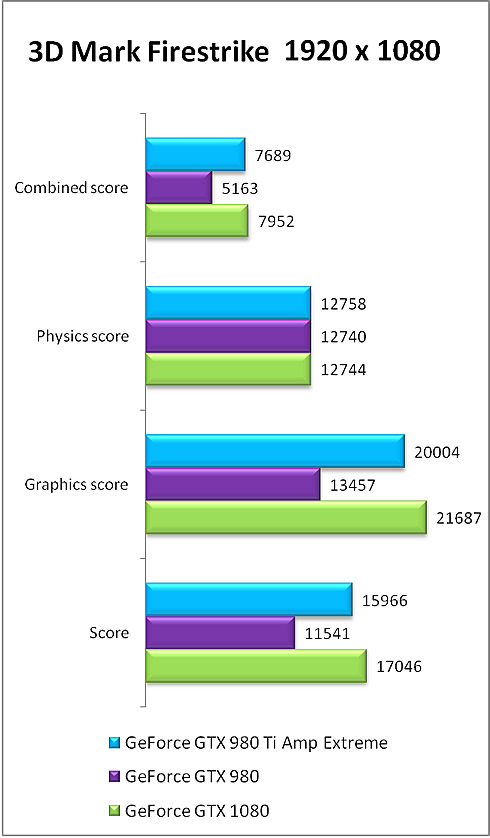
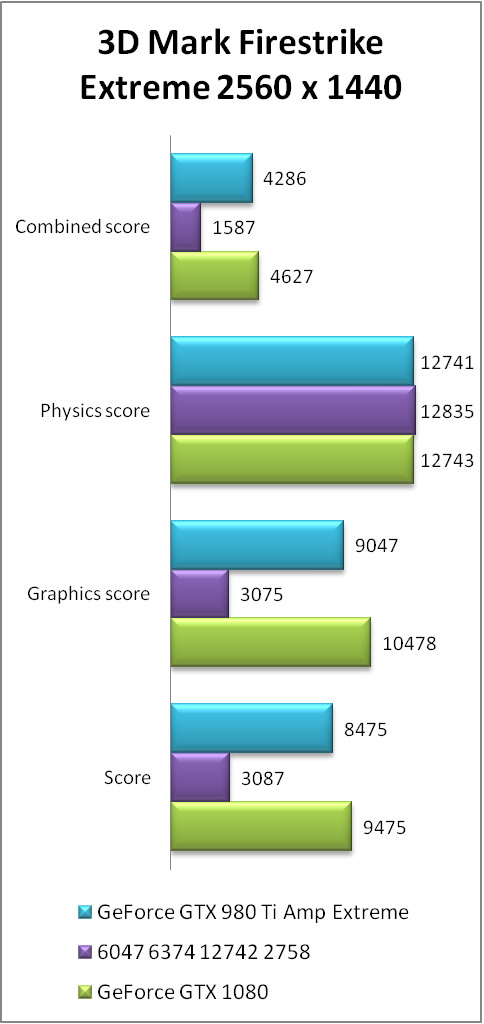



3. The Witcher 3: The Wild Hunt, Final Fantasy XIV, MHF benchmark
The Witcher 3: The Wild Hunt, benchmark again gave the top score to GeForce GTX 1080. The card has a 40-50% graphics performance lead over the GeForce GTX 980, and about 10% compared to the GeForce GTX 980 Ti AMP Extreme. The result is almost consistent to what we previously saw in the Graphics Score of 3DMark.
Obviously, the GTX 1080 can maintain more than 60 FPS during game play at 2,560 x 1,440.
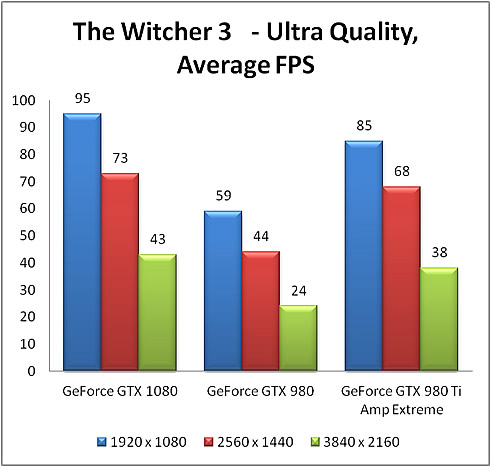
Moving on to the more demanding Final Fantasy XIV, as the load becomes heavier, the performance gap between the GTX 1080 and the GTX 980 becomes bigger, especially in the resolution of 3,840 x 2,160. We see a 70% to 80% lead over the GTX 980 and a smaller 10% lead over the GeForce GTX 980 Ti AMP Extreme.

The MHF benchmark showed almost the same trend, with the GeForce GTX 1080 to outperform the other GPUs.
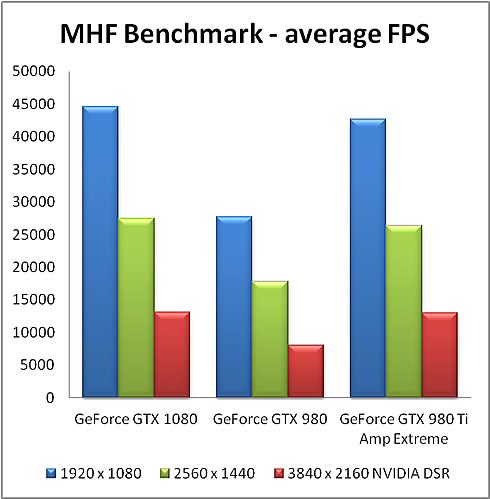
4. Dark Soul II, Assassin's Creed syndicate, power consumption
The Dark Soul III game's maximum frame rate is fixed to 60 fps. For this reason, all the cards on the chart below come side-by-side in the 1080p resolution.
At 3,840 x 2,160, the GeForce GTX 1080 and GeForce GTX 980 Ti AMP Extreme returned the same 45 FPS result. However, the GTX 980 Ti AMP Extreme consumed more power than the GTX 1080 in order to maintain the same result.

The very demanding Assassin's Creed syndicate title always requires high GPU resources in order to be playable. The GeForce GTX 1080 recorded the highest frame rate in all conditions.
At the resolution of 2,560 x 1,440 or lower, the lead of the GTX 1080 over the GTX980 is in the range of 40-50%.
But setting the game's resolution to 4K resolution and the setting to "Very High" , results to a minimal lead of the GTX 1080 over the GeForce GTX 980 Ti AMP Extreme. The 6GB of video memory on board of the GTX 980 Ti AMP Extreme has kept the card's performance high.
Any GPU would find it hard to cope with 4K gaming of the specific title, so using 2-way SLI would make sense here.

Power consumption
We measured the power consumption of the system during the benchmarks with each GPU. Both idle and maximum power figures we recorded.
The consumption of the GeForce GTX 1080 at idle about 40W, which is 5W less than the idle we recorded for the GTX 980 and 17W less than the idle power consumption we measured with the GeForce GTX 980 Ti AMP Extreme.
With the GTX 1080 running benchmarks at 1080p, we recorded a an average consumption of 250 ~260W, which is slightly higher number than the consumption of the GeForce GTX 980.
In terms of power-to-performance ratio, the GTX 1080 is a king, as it crashed the GeForce GTX 980 Ti AMP Extreme and delivered an astonishing benefit compared to the GeForce GTX 980.
5. Final thoughts
Although we did not have the chance to test the new GTX 1080 graphics card for along time, the Pascal graphics processor in the heart of the GTX 1080 is the fastest GPU ever to hit the streets. Our r limited benchmarks
showed that Nvidia's new baby is 10-15% faster than a factory overclocked GeForce GTX 980 Ti, a previous gen top-end card. The GTX 1080 should be also be
about 20% faster than a Titan X and also significantly faster than a Radeon R9 Fury X.
In addition, the card gives great potential for overclocking. Our fast tests showed that you may get a 90% (!) performance gain compared to a GTX 980, in specific games, such as the 'Rise of the Tomb Raider' at 4K resolution and Very High graphics settings.
In terms of power consumption, the GTX 1080 will offer a sizable power savings, with roughly a 70 – 80 Watt reduction, versus a previous generation Titan X or GeForce GTX 980 Ti-powered system.
The GTX 1080 also packs new software features. "Simultaneous multi-projection" is the name for a family of new technologies that improve how images are rendered in multi-monitor setups, boost in-game frame rates by rendering the edges of the screen at lower resolution, and improve VR rendering efficiency.Ansel is a new "in-game 3D camera system" that lets you pause the game, move the camera around the environment to get the perfect angle, then snap a screenshot that you can enhance with various filters, effects, and high-resolution options. You can also create "360 bubble" screenshots viewable inside VR headsets or Google Cardboad.Fast Sync is designed to work with e-sports games where your GPU’s pumping out hundreds of frames per second. It reduces screen tearing without introducing extra latency, skirting around V-sync’s major performance hindrances.
The GTX 1080 also supports HDR and copy-protected 4K streams, and offers a new "GPU Boost 3.0" system that lets overclockers create per-voltage clock frequency increases that match their individual GPU’s capabilities.
Priced at $599 (standard edition models), the GTX 1080 is much more affordable than the $1000 GeForce GTX Titan X, while delivering graphics efficiency with top performance. But have in mind, that the GTX 1070’s release is right around the corner, and Nvidia claims is Titan X-level performance and will retail at $370 - almost half the price of the GTX 1080 itself.
For now, Nvidia's seriously powerful gaming graphics card can be considered as the fastest consumer graphics processor on the planet. But it will be interesting to see how AMD’s Polaris and Vega 10 architectures stack up in the months ahead, as AMD readies new GPU offerings as well.
